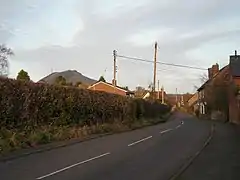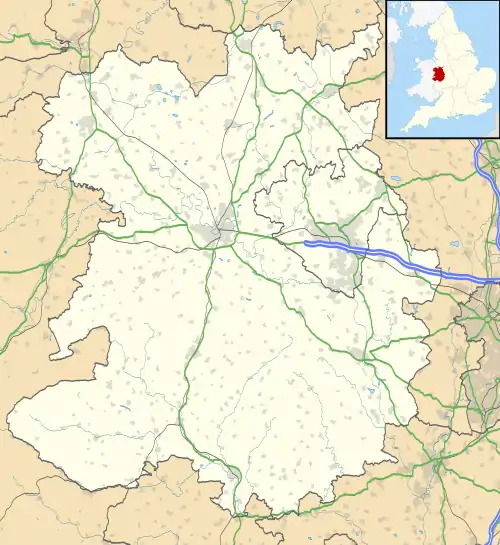Eaton Constantine
Eaton Constantine is a small village in the English county of Shropshire. It is located just off the B4380 road, between Atcham and Buildwas, near The Wrekin hill.
| Eaton Constantine | |
|---|---|
 Eaton Constantine, with The Wrekin in the distance | |
 Eaton Constantine Location within Shropshire | |
| OS grid reference | SJ596062 |
| Civil parish | |
| Unitary authority | |
| Ceremonial county | |
| Region | |
| Country | England |
| Sovereign state | United Kingdom |
| Post town | SHREWSBURY |
| Postcode district | SY5 |
| Dialling code | 01952 |
| Police | West Mercia |
| Fire | Shropshire |
| Ambulance | West Midlands |
| UK Parliament | |
The theologian Richard Baxter (1615–1691) lived here in his boyhood. His childhood home, now called Baxter's House (a private residence), is a 16th-century timber-framed house in the centre of the village.
Near Eaton Constantine are the remains of a Roman vexillation fortress and three marching camps near a bend in the River Severn. The fortress lies in open farmland on a low south-eastward projecting spur between Ranslet House and Eye Farm. It was defended by a triple-ditch system measuring about 920 x 1,050 feet (c.280 x 320m) within the defences, which enclosed an area of just under 22¼ acres (c.9ha). This substantial defensive system indicates that this was no ordinary marching encampment, and its size would have been sufficient to house a substantial force of around 2,500 Roman legionaries and auxiliary soldiers. The fortress was probably occupied by a contingent of Legio XIV Gemina, together with a couple of auxiliary cavalry units.
The place-name 'Eaton Constantine' does not refer to the Roman military presence; 'Eaton' means 'island town or settlement', and the land was held by Thomas de Cotentin from Cotentin (in Normandy) in 1242.[1]
References
- Eilert Ekwall, Oxford Dictionary of English Place-names